Slovenia, the Triglav and Narodni National Park
The wildflowers of Slovenia...
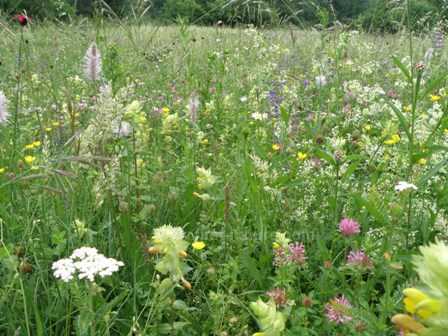
Not a dream but the reality! A wildflower meadow in Slovenia's Triglav National Park
The summer of 2011 saw the realisation of a long-held ambition to visit Slovenia. Somehow over the years my subconscious had become permeated with the idea of Slovenia being synonomous with walks in warm, sunlit meadows filled with brightly coloured wildflowers and alive with the sound of buzzing insects as they foraged for nectar.
Dream walks were always accompanied by the sound of birdsong, the air was clean, the rivers pristine and the peace overwhelming; but then dreams can be like that.
So often the reality is a dreadful jolt, or at best only partially relives the dream because there are only fragments of the imagined scenery to be found at the end of long drives through urban nightmares. Think what it would be like to wake up and have the dream continue; think about visiting Slovenia, because that's what happens.
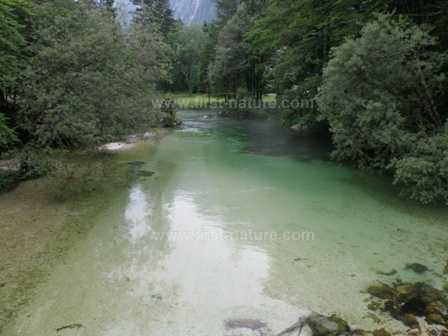
The pristine rivers in Slovenia are famous for their purity
When writing about holidays it is so easy to fall into the trap of endlessly burbling on in a series of cliches about the scenery, the food, the welcome, and all the other elements that are so important when looking back on the event and filing it in the 'absolutely wonderful' or 'never again' pigeon holes for future reference.
First impressions are so significant and often inform more of the memory of an event than anything else. Our first impression of Slovenia was excellent, and it was this: where was the litter that plagues our towns and countryside and makes me so ashamed of being British today? There wasn't any. In ten days I counted just one piece of litter, which I immediately assumed must have been dropped by a tourist. Probably from Britain!
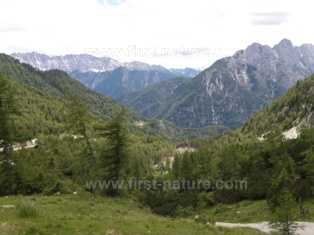
There's always a mountain in the background - even when you are on top of one!
So what is Slovenia like and why is it so different? Think of a country about the size of Wales. It is 7,780 square miles (20,151 square kilometres) in size, and with a similar sized population of 2,500,000. Slovenia is in the centre of Europe with lots of borders: Italy in the west, Croatia in the southeast, Hungary in the northeast and Austria in the north. In the minds of many people Slovenia is associated with the recent and dreadful ethnic upheaval leading to the partitioning of the former Yugoslavian State. In fact, Slovenia severed itself from Yugoslavia with relatively little fighting and became a separate entity on 25th June 1991. Since then it has realigned itself towards Western Europe and joined the European Union in 2004. Its economic situation today is better than many other countries in Europe, but it is the emphasis that Slovenia and the Slovenians place on the importance of their environment that sets them apart from other countries and which has resulted in the country - or should I say countryside - that we saw during our visit.
Although small, Slovenia has a wide diversity of habitats many of which are protected areas. Thirty-six percent of the country's land area is protected in one way or another. There are close on 300 Natura 2000 designated protected areas, which is the highest percentage among the EU states. Other designations include national parks and nature parks, and it was the largest of the national parks, Triglav National Park, where we spent the majority of our ten days in Slovenia during June 2011.
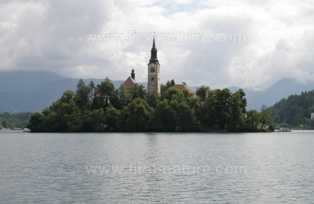
Beautiful Lake Bled
The country is surrounded by mountains. In the north there are the Julian, Karvanke and Kamnik Alps, and in the south the Dinaric Alps. Wherever you are the scenery has a mountain backdrop, even when you are on top of one!
The mountains account for more than spectacular scenery: they have a profound effect on the weather, too, making it changeable and unpredictable. Visiting in June meant that temperatures were always comfortable even when sunshine was replaced by the violent thunderstormsso typical of this region. Nothing lasts for long, though, and the storms and rain were shortlived and soon replaced by bright sunshine again.
Our holiday in Slovenia was unusual in that we stayed in an hotel rather than in the self-catering accommodation that we usually favour. A birthday, an anniversary and the company of a dear friend accounted for this deviation from normal practice, and we stayed in an hotel that was familiar territory to our friend - the Grand Hotel Toplice (pronounced Toplitsa, not 'topless'!) in Bled.

Great Masterwort (Astrantia major)
Bled is a lovely little town at the very centre of which is the Lake Bled so familiar to any of us who spend time browsing travel brochures or websites. The lake is a sensation and one that we were able to enjoy on a daily basis, as we had a 'room with a view' and a balcony overlooking the lake. We cannot recommend the hotel too highly, and if the scenery were not enough the comfort of the rooms, the service and the food would have more than compensated.
Our first port of call was the Tourist Information Centre at Bohinj (pronounced Bockheen) to enquire about the best places to see wildflowers. Regrettably we had just missed the 5th International Wildflower Festival, which had been running in Bohinj the week before; nevertheless, we were given a little guidebook to wildflower walks in the immediate vicinity of Bohinj as well as maps and the contact details for a local botanist who was happy to accompany visitors on walks - just the ticket! The maps and guidebook were so good that we had no trouble in finding the starts of the walks and were immediately able to plan a series of excursions by car and on foot which would ensure that we got to see as much as possible during our stay.

Yellow Bellflower (Campanula lutea)
The mountainous terrain of Triglav National Park makes it an obvious place to look for alpine wildflowers, but the wealth of flowers found in each of the diverse habitats that we visited makes it impossible to choose any particular category of plants or places in preference to another, but lets begin in those 'dream meadows', and remember the wonderful comment I found in a Slovenian book about wildflowers, 'High mountain plants grow in valleys until found by a botanist!'
The 'Alpine Dry Meadows' that abound with such magnificent displays of wildflowers are not difficult to find in the area: they are everywhere and can just as easily be visited from the side of a main road as they can by driving or walking up into the mountains. We did a mixture of both and the list of species we found, many of which we still have to identify, was quite mind-blowing.
This is a place to realise botanical wishlists, to see Dusky Crane's-bill (Geranium phaeum) growing in the wild alongside the Carnic Lily (Lilium carniolicum), Great Masterwort (Astrantia major), Yellow Bellflower (Campanula lutea), Wild Sweet William (Dianthus barbatus), three colour variations of Meadow Clary (Salvia pratensis) and Field Gentian (Gentianella campestris).
Orchids that live in this colourful environment have a much tougher time in competing for our attention than they usually do, but we still found them! Two Fragrant Orchid species occur together, Chalk Fragrant-orchid (Gymnadenia conopsea) flowers beside Gymnadenia Odoratissima. As always when you get a chance to compare two species so easily, some of the subtle differences become more obvious; but it is the much stronger and sweeter perfume of the latter that immediately gives it away. The Burnt Orchid (Neotinea ustulata) also puts in an appearance in this lovely setting.
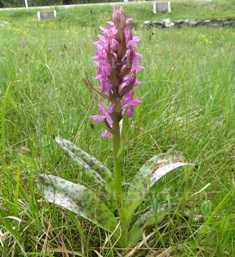
Western Marsh-orchid (Dactylorhiza majalis)
The woodlands in Triglav National Park are also full of flowery delights. Lower altitude forests and woodlands consist largely of mature Beech and Oak trees, and we can only imagine how wonderful the displays of fungi must be there in the Autumn - another dream that needs to be translated into reality, and soon.
In the meantime we discovered more Bird's-nest Orchids (Neottia nidus-avis) than we have ever seen before - large clumps of them. They were so numerous that they even spilt out of the woodlands and onto the roadside verges and path edges. We also found the impossibly elusive (in other countries) Coralroot Orchid (Corallorrhiza trifida) in larger numbers than we had seen before; the plants were more robust, too, and some grew on the roadside verges and were much greener than those we had seen in the past. Lesser Butterfly-orchids (Platanthera bifolia) were also a frequent find on woodland edges, as were two species of Helleborines - Sword-leaved Helleborine (Cephalanthera longifolia) and (another 'first' for us) White Helleborine (Cephalanthera damasonium). Again we had the luxury of being able to make direct comparisons between these two very similar species.
The Sword-leaved Helleborines did not always have a very conspicuous and bright yellow 'blob' on the lip, but the leaves of the White Helleborine were broader at the base of the stem and did not grow in quite the regimented rows on either side of the stem as they do in Sword-leaved Helleborine.
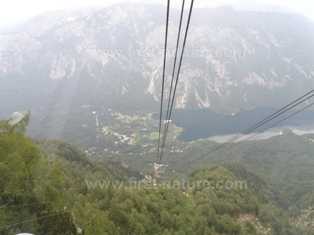
Going down! The view from the Vogel Cablecar
Another interesting find in the woodlands was the parasitic toothwort Lathraea squamaria. Although it can be found in the UK and Ireland we had not seen it before. Reputed to parasitise mainly Hazel, these plants were clearly growing under Beech trees - and in large numbers, too.
Marshier areas which we came across on some of our drives along mountain tracks yielded marvellous displays of Globeflowers (Trollius europaeus) which are now so uncommon in Britain except in certain parts of North Wales and Scotland. Along with these we found excellent specimens of Western (or Broad-leaved) Marsh-orchid (Dactylorhiza majalis). This orchid is sometimes referred to as the Irish Marsh-orchid and is most likely (in Britain and Ireland) to be found in The Burren or on the western coast of Ireland where I believe I have seen it. In Wales we are also reputed to have our own 'version' of this orchid which is now referred to as Dactylorhiza majalis var. cambrensis. For once I felt certain that I had actually found it in Slovenia and this may help me to recognise it better when I see it in Wales or Ireland in the future.
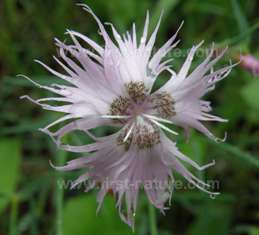
Dianthus sternbergii
Many of the walks in Slovenia are challenging because of the mountainous terrain, but to leave without getting right up into the mountains to see the alpine plants was unthinkable. Fortunately, help was at hand in the form of the Vogel Cablecar. If you don't like heights this trip is most definitely not for you, but it is a wonderfully convenient way of getting very high up very quickly - in around six minutes, actually. The trip opened up yet another world of plants to us, although we were too early to see some of the later-flowering species. There were vast drifts of Globeflowers and lots of the lovely Alpine Clematis (Clematis alpina) cascading down over the rocks. Alpine Flax (Linum alpinum) was in full flower as was the rather sinister-looking Beakless Red Lousewort (Pedicularis recutita).
If the cablecar is too much to bear, it is possible to see some of the lovely alpine species of this part of Slovenia by driving to Kranjska Gora, to the northwest of Bled, and from there up to the Austrian border. It was on this trip that we found another of the 'must see' flowers of the region, Sternberg's Pink (Dianthus sternbergii) and also Clusius's Gentian (Gentiana clusii).
Towards the end of our trip we had a lovely walk with local Botanist Marija Zupanc. I would normally want to do this earlier on a field trip (and we had managed so well on the detailed information we had received from the Tourist Office in Bohinj), but the timing worked very well and Marija was able to help with many identification queries that had arisen from earlier excursions. Our guide took us up through a steep, wooded river valley behind Lake Bohinj and into some truly magnificent wildflower meadows. On the way up Marija pointed out Alpine Butterwort (Pinguicula alpina), and settled our minds about the correct identification of White Helleborine versus Sword-leaved Helleborine. Other lovely flowers along the river included Greater Meadow-rue (Thalictrum aquiligefolium) and the strange little greenish-yellow flowers of Haquetia epipactis. We found a number of fungi species, too. Once in the meadows it was not long before Marija found Carnic Lilies, one specimen of Martagon Lily (in bud), several orchid species and a host of other wonderful flowers that we might otherwise have missed. Our walk took us up to a 20-metre waterfall and then back down the other side of the river, but not before stopping for a welcome cup of tea on the way.

Gentiana clusii
Slovenia revisted - 2014
It is hard to believe that it is three years since the visit described above - definitely high time to return to this beautiful country to see more its wildlife and wildflowers.
We arrived at roughly the same time, but this year is very different from our last visit: the spring was earlier this year and the weather has been much warmer. As a result many of the species (particularly the orchids) were over especially in the valley meadows where the first cut for hay had already been made. The bonus was that we were seeing later-flowering species that we did not see on the last trip and, by driving up higher into the mountains, we were able to see a mixture of new (to us) species as well as some old friends. Two special wildflower species stand out. Firstly the discovery of the Bohemian Early Purple Orchid Orchis Ovalis growing in an open sunny clearing high up above Bohinj Lake and, secondly, the fabulous Gentiana clusii growing very high up at the Vrsic Pass which separates the Trenta Valley (in the west) from the Sava Valley which extends down to the Bohinj and Bled areas.

Inside the Postojna Caves
This second visit enabled us to visit two special places that should be on every visitor's list of 'places to go' when in Slovenia. For Botanists (amateur as well as professional) a visit to the Juliana Alpine Botanical Garden in the Trenta Valley is a rare delight. If you are more interested in geology and animals then a trip to the cave system at Postojna is both thrilling and, because of the addition of a relatively new 'zoo' of the strange creatures that can survive in total darkness, profoundly interesting.
Juliana Alpine Garden
The Slovenians are far from impervious to their natural environment and value it deeply. There is a long history of interest in the very special alpine flora which is found throughout so much of the country, and several alpine gardens have been established since the late 1700s. 1810 saw the establishment of an alpine garden in Ljubliana, and this was followed in 1926 by the Juliana Alpine garden which was founded by a Frenchman Albert Bois de Chesne.
The Juliana garden is not just inspirational because of the around 600 alpine plants which have been planted there, but also because, despite all the conflicts that have occurred since it was begun, the love and dedication of a few individuals have ensured that it has survived so that we can enjoy it and marvel at the plants today. May and early June are the best time to visit this beautiful place to see the majority of the rare flower species, but there is always something there to admire even later in the year. The meadows are exceptionally rich in butterflies, moths and other insects and, in autumn, many species of fungi appear to surprise and delight later visitors to the garden.
Postojna Caves
An hour's drive south from the Bled area will bring you to Postojna and its main tourist attraction - the caves. This is a big and well organised exhibit with plenty of parking if you chose to take your own transport rather than go on one of the many excursions to the venue.
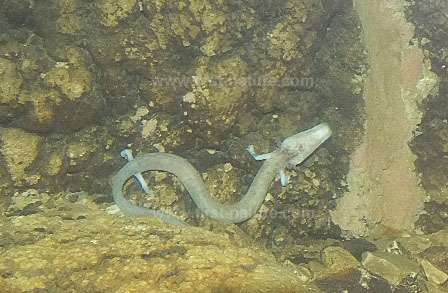
Proteus anguinus - one of the 98 species of animals that live in the caves at Postojna
Small trains take visitors part way into the cave system and thereafter you join an accompanied walk (steep in places) through some of the amazing underground 'galleries' with their astonishing stalagtites and stalagmites. The trip takes around 2 hours in total.
No visit is complete without going into the new display which shows the strange creatures which survive in this inhospitable environment, many of which are blind. Of particular note is the so-called Human Fish Proteus anguinus. It's white skin is said to look similar to our human skin, and this amphibian with its unformed eyes breathes through gill structures which lie just behind its head as well as with lungs and through its skin. It has an inner ear, which serves both the purposes of balance and hearing. Its two pairs of tiny legs, which are relatively far apart, have three digits at the front and two at the back. Its tail is surrounded by a thin fin makes it possible for the Proteus to swim.
Proteus anguinus feeds on small crabs, worms, snails and other aquatic non-vertebrates. It has a life expectancy of up to 100 years and can survive without food for several years in a row. It is reproduced by means of eggs, which females lay underneath flat stones.
Proteus anguinus is by no means alone in the dark habitats of the Postojna Caves - it has plenty of company with at least another 98 species of animals having been recorded there.
For those interested in wildflowers and wildlife Slovenia is a wonderful country to visit and much less well-trodden than many other countries in central Europe. It is easily accessible by air (a two-hour flight from Gatwick on Adria Airlines), or a three or four day journey by car or motorhome with a few stops along the way if you have the time. Accommodation is excellent whether you chose an hotel, a campsite or a self-catering apartment. We cannot recommend it highly enough.
Contacts:
Bohinj Tourist Office (Turizem Bohinj): Email: info@bohinj.si Web: www.bohinj.si
Grand Hotel Toplice, Bled: Email: ghtoplice@hotelbled.com Web: www.hotel-toplice.com
Botanical Excursion Leader:Email: marija.zupanc1@siol.net
Wildflower species in Slovenia
Scientific name |
English name |
Slovenian name |
|---|---|---|
| Ajuga pyramidalis | Pyramidal Bugle | Piramidasti skrečnik |
| Anacamptis coriophora | Bug Orchid | |
| Anacamptis fragrans | Fragrant Bug Orchid | |
| Anacamptis morio | Green-winged Orchid | |
| Anacamptis pyramidalis | Pyramidal Orchid | Piramidasti pilovec |
| Anthyllis vulneraria | Kidney Vetch | Alpski ranjak |
| Astrantia major | Mountain Sanicle, Great Masterwort | Veliki zali kobulček |
| Campanula thyrsoides | Yellow Bellflower | Šopasta zvončica |
| Cephalanthera damasonium | White Helleborine | Bleda naglavka |
| Cephalanthera longifolia | Sword-leaved Helleborine | Dolgolistna naglavka |
| Cephalanthera rubra | Red Helleborine | Rdeča naglavka |
| Chamorchis alpina | False Orchid | Alpska cepetuljka |
| Cichorium intybus | Chicory | Potrošnik |
| Clematis alpina | Alpine Clematis | Planinski srobot |
| Corallorhiza trifida | Coralroot Orchid | |
| Cypripedium calceolus | Lady's-slipper Orchid | Lepi čeveljc |
| Dactylorhiza fuchsii | Common Spotted-orchid | Fuchsova prstasta kukavica |
| Dactylorhiza maculata | Heath Spotted-orchid | Pegasta prstasta kukavica |
| Dactylorhiza majalis | Broad-leaved Marsh-orchid | Majska prstasta kukavica |
| Dactylorhiza viridis | Frog Orchid | |
| Drosera rotundifolia | Round-leaved Sundew | Okroglolistna rosika |
| Epipactis atrorubens | Dark-red Helleborine | Temnordeča močvirnica |
| Fallopia japonica | Japanese Knotweed | |
| Fragaria vesca | Wild Strawberry | Navadni jagodnjak |
| Fritillaria meleagris | Snake's-head Fritillary | Močvirski tulipan |
| Galium verum | Lady's Bedstraw | Prava lakota |
| Gentiana verna | Spring Gentian | Tržaški svišč |
| Geranium phaeum | Dusky Crane's-bill | Rjavordeča krvomočnica |
| Geranium robertianum | Herb Robert | Smrdljička |
| Geranium sangineum | Bloody Crane's-bill | Krvavordeča krvomočnica |
| Geranium sylvaticum | Wood Crane's-bill | Gozdna krvomočnica |
| Geum rivale | Water Avens | Potočna sretena |
| Geum urbanum | Wood Avens | Navadna sretena |
| Glechoma hederacea | Ground-ivy | Bršljanasta grenkuljica |
| Gymnadenia conopsea | Chalk Fragrant-orchid | Navadni kukovičnik |
| Gymnadenia nigra ssp. rhellicani | Black Vanilla Orchid | Črna murka |
| Gymnadenia odoratissima | Fragrant Orchid | |
| Gymnadenia rubra | Red Vanilla Orchid | Rdeča murka |
| Haquetia epipactis | Haquetia | |
| Iris pseudacorus | Flag Iris | Vodna perunika |
| Knautia arvensis | Field Scabious | Njivsko grabljišče |
| Lamium purpureum | Red Dead-nettle | Škrlatnordeča mrtva kopriva |
| Linaria vulgaris | Common Toadflax | Navadna madronščica |
| Linum narbonense | Beautiful Flax | Francoski lan |
| Lotus corniculatus | Bird's-foot Trefoil | Navadna nokota |
| Lychnis flos-cuculi | Ragged Robin | Kukavičja lučca |
| Lysimachia nummularia | Creeping Jenny | Okroglolistna pijavčnica. |
| Lysimachia vulgaris | Yellow Loosestrife | Navadna pijavčnica |
| Lythrum salicaria | Purple Loosetrife | Navadna krvenka |
| Malva moschata | Musk Mallow | Muškatni slezenovec |
| Malva sylvestris | Common Mallow | Gozdni slezenovec |
| Melampyrum nemerosum | Yellow Cow-wheat | Podlesni črnilec |
| Lilium carniolicum | Carnic Lily | Zlato jabolko |
| Lilium martagon | Martagon Lily | Turška lilija |
| Melampyrum pratense | Common Cow-wheat | Navadni črnilec |
| Melittis melissophyllum | Bastard Balm | Medenika |
| Menyanthes trifoliata | Bog Bean | Navadni mrzličnik |
| Mercurialis perennis | Dog's Mercury | Trpežni golšec |
| Mimulus guttatus | Monkey Flower | Zivorumeni krinkar |
| Muscari neglectum | Grape Hyacinth | Grozdasta hrušica |
| Neottia nidus-avis | Bird's-nest Orchid | Rjava gnezdovnica |
| Neottia ovata | Common Twayblade | |
| Oenothera biennis | Evening Primrose | Dvoletni svetlin |
| Ophrys apifera | Bee Orchid | Čebeljeliko mačje uho |
| Ophrys insectifera | Fly Orchid | Muholiko mačje uho |
| Orchis militaris | Military Orchid | Čeladasta kukavica |
| Orchis ovalis | Bohemian Early Purple Orchid | |
| Orchis purpurea | Lady Orchid | Škrlatnordeča kukavica |
| Neotinea tridentata | Toothed Orchid | Trizoba kukavica |
| Neotinea ustulata | Burnt Orchid | Pikastocvetna kukavica |
| Ornithogalum umbellatum | Star-of-Bethlehem | Kobulasto ptičje mleko |
| Oxalis acetosella | Wood-sorrel | Navadna zajčja deteljica |
| Paris quadrifolia | Herb Paris | Volčja jagoda. |
| Parnassia palustris | Grass of Parnassus | Močvirska samoperka |
| Pedicularis verticillata | Verticillate Lousewort | Vretenčasti ušivec |
| Pinguicula vulgaris | Butterwort | Navadna mastnica |
| Platanthera biofolia | Lesser Butterfly-orchid | Dvolistni vimenjak |
| Platanthera chlorantha | Greater Butterfly-orchid | Zelenkasti vimenjak |
| Polygala vulgaris | Milkwort | Navadna grebenuša |
| Potentilla anserina | Silverweed | Gosji petoprstnik |
| Potentilla erecta | Tormentil | Srčna moč |
| Primula elatior | Oxlip | Visoki jeglič |
| Primula farinosa | Bird's-eye Primrose | Moknati jeglič |
| Primula veris | Cowslip | Belopolsteni pomladanski |
| Primula vulgaris | Primrose | Trobentica |
| Pseudorchis albida | Small-white Orchid | Belkaste ročice |
| Pyrola rotundifolia | Round-leaved Wintergreen | Okroglolistna zelenka |
| Ranunculus acris | Meadow Buttercup | Ripeča zlatica |
| Ranunculus ficaria | Lesser Celandine | Lopatica |
| Reseda lutea | Wild Mignonette | Rumeni katanec |
| Scilla bifolia | Alpine Squill | Dvolistna morska čebulica |
| Silene dioica | Red Campion | Rdeči slizek |
| Solanum dulcamara | Woody Nightshade | Grenkoslad |
| Solidago virgaurea | Goldenrod | Navadna zlata rozga |
| Spiranthes spiralis | Autumn Lady's-tresses | Zavita škrbica. |
| Stellaria holostea | Greater Stitchwort | Velecvetna zvezdica |
| Symphytum officinale | Common Comfrey | Navadni gabez |
| Thalictrum aquilegifolium | Greater Meadow-rue | Vetrovka |
| Trifolium pratense | Red Clover | Crna detelja |
| Trollius europaeus | Globe Flower | Navadna pogacica |
| Tussilago farfara | Colt's-foot | Lapuh |
| Valeriana dioica | Marsh Valerian | Dvodomna špajka |
| Veronica chamaedrys | Germander Speedwell | Vrednikov jetičnik |
| Vinca minor | Lesser Periwinkle | Zimzelen |
| Viola riviniana | Common Dog-violet | Rivinova vijolica |